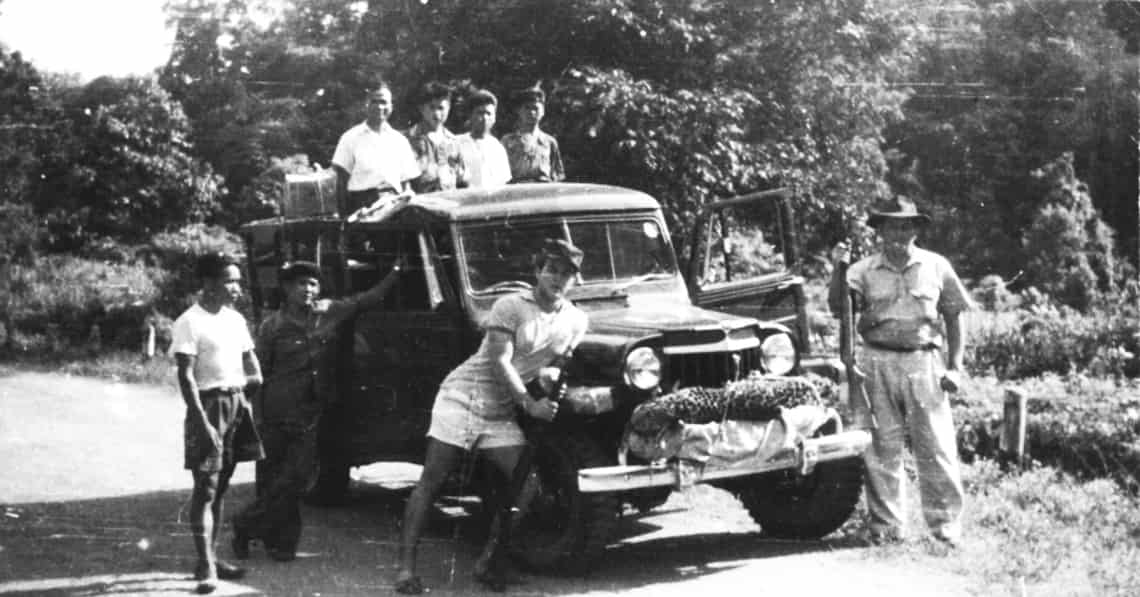
Harold Young, born and raised in the mountains of Burma and China, was one of dozens of missionaries recruited by the American Office of Strategic Services (OSS) to shed light on the darkest fringes of US national security in the region. Speaking six local languages fluently, Harold and his family were prized for their ability to influence myriad ethnic groups in Southeast Asia who revered them as prophets and bringers of the Word of God. Unlike the European colonial powers, whose residents served for decades in Africa and Asia, the only Americans during the Cold War with on-the-ground experience and contacts abroad were missionaries.
Harold was born in 1901 to a Baptist missionary family in Keng Tung, Burma. His father, William M. Young, had great success converting the Lahu and Wa hill tribes, both of which held legends predicting a white man holding a white book would one day arrive to bring salvation, and the long lost written word, to the mountain people. When Harold’s father appeared in Keng Tung wearing white Baptist robes and clutching a white bible, the villagers knew their prophecy was fulfilled and began begging to be baptised.
Harold grew up at the mission station and, nearly from the time he could walk, accompanied his father on trips through the jungles, evangelising village to village for months on end. The Lahu and Wa revered the Youngs as prophets. But gangs of thieves, bandits and wild headhunters roamed the no-man’s land where the Youngs preached and wanted them dead. Local warlords viewed the Youngs as a threat to their power, and offered pony-loads of silver to anyone who could bring them the decapitated skulls of the missionaries. But every time a group of assassins leapt out from a jungle ambush, they claimed to see angelic figures and halos surrounding the missionaries, and they’d drop to their knees and beg forgiveness.
Fantastical tales of holy protection spread through the hills, convincing even more tribesmen to ask William Young for baptism. His fulfillment of the “white man, white book” prophecy, and his seeming invincibility against the harsh onslaught of would-be assassins, earned William the Lahu title of “Jaw Maw,” meaning “Man-God,” and he was venerated as a near-deity.
When William died in 1936, the Jaw Maw title was passed down to his two sons, Harold and Vincent, who continued their father’s ministry. In 1942, Harold was working in Taunggyi when Japanese planes began bombing the outskirts of the city. Although he was an American, Harold was conscripted into the British Army under extenuating wartime circumstances. He was given the rank of captain and put in command of two battalions of Shan warriors, totalling more than 2,000 troops, tasked with fighting Japanese ground forces and safeguarding the private property of wealthy British administrators and Shan royalty. Although he had no prior military training, Harold had grown up hunting with the Lahu and Wa, and was used to handling guns and navigating the rugged terrain of the Burmese highlands. He led the battalions for months, issuing commands fluently in their native Shan language, until the Japanese bombing became untenable and he was forced to escape to India.
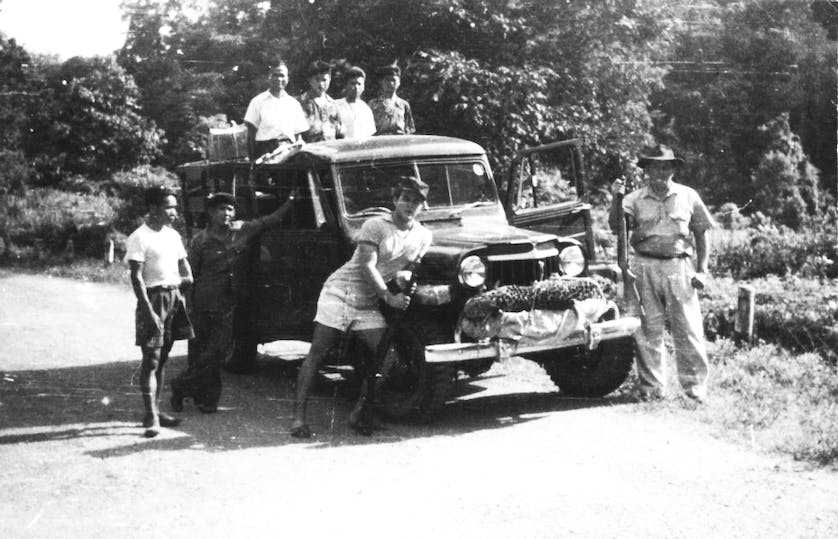
Bill, Harold and Lahu boys on hunting trip, 1951
Having lost Burma, the Allies sided with Chiang Kai-shek to push the Japanese out and reclaim the country. The OSS built a new road to run supplies from India to China, sent airlifts of weapons over the Himalayas, and developed guerilla teams of Kachin warriors accompanied by American field advisors to perform hit-and-run attacks on the Japanese. To assist in these operations, Harold Young was recruited by the OSS as a jungle survival expert, using his four decades of experience in the hills to teach the guerilla teams how to find food and water, build shelters, hunt and trap game, and set up pitfalls and ambushes against enemies. Harold eventually compiled his coursework into a field manual for the US Army.
After defeating the Japanese, the British resumed administration of Burma and installed Harold as Assistant Superintendent of the Northern Shan States. He was given command of thousands of Lahu, Shan, Wa and Ghurka troops, responsible for demarcating the Burma-China border, suppressing bandits and robber bands, and arresting warlords suspected of collaborating with the Japanese during WWII. Harold tried and convicted many influential warlords, including Khun Ja (uncle of the infamous “King of Opium” Khun Sa), sentencing him to execution by gunshot to the head at the banks of the Irrawaddy.
In 1947 the OSS was restructured into the Central Intelligence Agency (CIA) to better deal with the growing threat of communism. In 1948 Burma gained independence from the British, and Harold and his family (along with most westerners) had to leave the country. In 1949 the communists seized control of China, and stormed North Korea, starting the Korean War in 1950.
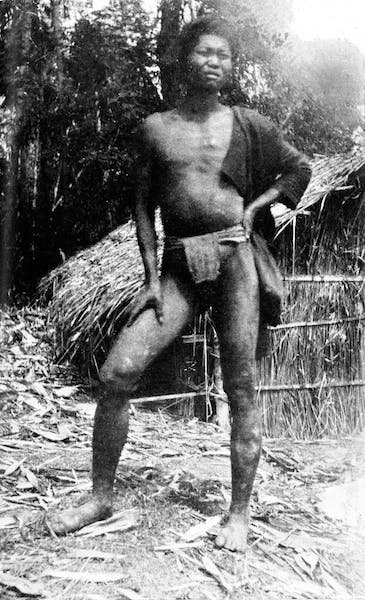
A wild Wa, 1898
The CIA wanted desperately to halt the flow of communism into Indochina, and decided to set up shop in Chiang Mai. The United States signed a lease in 1950 on the Chedi Ngarm (meaning “Beautiful Pagoda”) Palace, the former royal residence of Kaew Nawarat, the last King of Lanna and Prince of Chiang Mai. After renovation and repurposing, the American Consulate official opened in 1951, serving as a clandestine base for anticommunist operations in Southeast Asia. In the same year, Harold Young was picked up by the CIA and he and his family moved to Chiang Mai. Today, while most other consulates have moved from their original location, the American office remains in the same historic spot on the western bank of the Ping River at the Giu Chedi roundabout across from Muang Mai Market.
The first thing the CIA did to block communism from seeping into Thailand was to develop an elite police border guard, called the Border Patrol Police (BPP). This joint Thai-CIA police force was greatly supported by the Royal Family and was tasked with protecting Thailand’s northern borders with Burma and Laos. Since the BPP consisted mostly of ethnic Thais with little to no experience working with tribal minorities in the mountainous border areas, Harold was brought in as an ethnographic, linguistic, and (of course) jungle survival instructor.
The BPP training ground was an empty field next to Wat Suan Dok on Suthep Road. In those days, Wat Suan Dok was far away from the main population of Chiang Mai City. Suthep Road was just unpaved dust and dirt, and, before the creation of Chiang Mai University (and subsequently, Nimmanhaemin Road) in 1964, there were relatively few people living at the foothills of Doi Suthep. Harold and the BPP could thus train there without disruption. Today, there are no remnants of the military training grounds since the Suan Dok School and dormitory units were built on the land. The only hint of what used to be there is The Hilltribe Product Promotion Centre (another royally supported project), bearing a sign reading “BPP & Hill Tribe” at the entrance. There is even a “BPP Coffee House” attached to the western side where you can get yourself an elite cup of Special Forces cappuccino and reminisce on days past.
The next thing the CIA did was to rearm Chiang Kai-shek’s Kuomintang (KMT) troops in Shan State, Burma, where they had fled when Mao’s communists seized power in 1949. In 1951 the CIA began to send airlifts of weapons and rice to the KMT, so they could regroup and storm back into China to spark an anticommunist uprising. The KMT needed to plan the timing of these attacks into China, so the CIA called on Harold to create Lahu intelligence-gathering teams to report on communist troop strength, positions, movements, and armaments so as to perfectly execute the timing of the raids.
Harold brought in his eldest son, Gordon (author of the well-known book Tracks of an Intruder), who had served in the Korean War as a radio operator. Gordon used his expertise in radio communications, and Harold used his prestige and contacts as Jaw Maw to recruit, train and dispatch a network of Lahu spies along the China-Burma border. Father and son, both born at the mission station, spoke perfect Lahu, Wa, Shan and Chinese, and received and transmitted all radio communications fluently in the native tongues of their agents.
During these CIA operations, Harold and his family lived in a beautiful property at the base of Doi Suthep called Weluwan Villa. Go to the top of Suthep Road, past Chiang Mai University heading toward the Galae Restaurant, and just as you head up the steep incline you’ll see a fenced off property on the right-hand side. This is Weluwan Villa, belonging to the illustrious Nimmanhaemin family. Harold rented the house from Guy and Gimhaw (aka Buphan) Nimmanhaemin, who soon became Harold’s close friends.
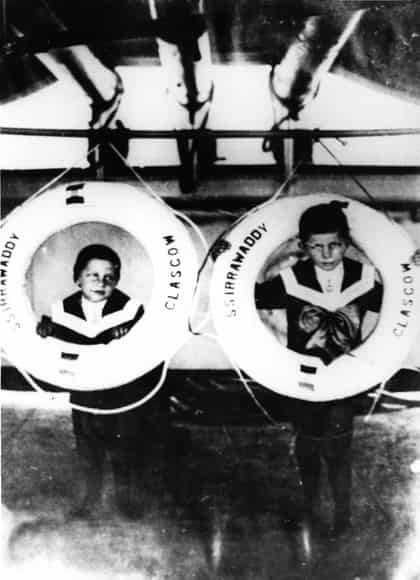
Vincent and Harold’s first trip to US, 1909
Buphan is the daughter of Nai Luong Anusarn (of the Night Bazaar’s Anusarn Market and the owner and founder of Wororot Market), and the mother of Kraisri Nimmanhaemin, the famed archeologist who discovered the Mrabri tribe (Spirits of the Yellow Leaves), invented khantoke dinners, and is considered one of the greatest modern proponents of Lanna and Northern Thai culture. Needless to say, these were some of the most influential citizens of Northern Thailand, and the sprawling grounds and secluded location of Weluwan Villa fast became a social centre for the upper strata of both Thai and farang society in 1950s Chiang Mai.
Harold hosted Thai, British, French and American dignitaries at the Villa, and took them on hunting trips in the jungles of Doi Inthanon and Chiang Dao. Homesick CIA and USAID families were overjoyed to have a place where their families could celebrate American holidays like Thanksgiving and the 4th of July, hosted and catered by Harold’s wife, Ruth Young. Ruth also helped found the Chiang Mai branch of American University Alumni (AUA) and was head teacher for the first graduating class of 1957.
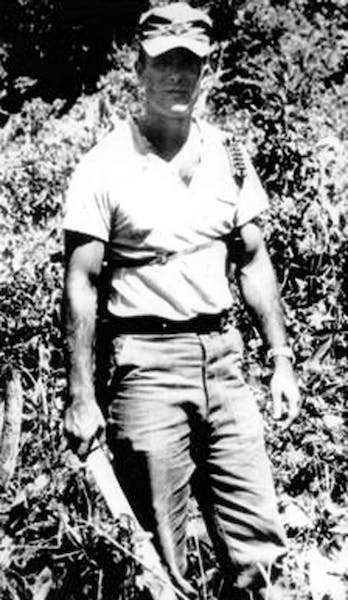
Bill Young at Ban Huay Sai, Laos, 1962
Like any good spy, Harold needed a cover story to disguise his covert activities in Chiang Mai. A true man of the mountains, he decided on professions closest to his heart, becoming both an entomologist and a naturalist. But unlike most agents, Harold was very passionate about his cover. He provided insect samples to the American Museum of Natural History, was frequently called upon by the Thai government as a nature conservation specialist, and collected dozens of exotic animals on the grounds of the Weluwan Villa property that were visited and beloved by kids of all ages.
Continuously expanding, Harold’s collection eventually grew too large for the Villa to handle. So the Nimmanhaemins convened a meeting with the governor of Chiang Mai and the Royal Forestry Department, who agreed to grant enough land for Harold to start a proper zoo at the base of Doi Suthep just south of Huay Kaew Road. On April 6th 1957, Harold Young became the first director of the Chiang Mai Zoological Gardens, a title he held until the day he died, nearly 18 years later. If you visit Weluwan Villa today, the house is uninhabited and the animals are long gone, but you can still see the original bird and monkey cages, rusted and being overtaken by jungle.
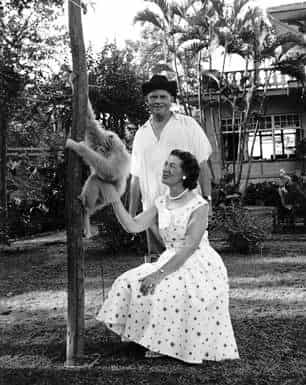
Harold and Ruth with gibbon at Weluwan Villa, original CM Zoo, approx 1956
The Chiang Mai Zoo became a form of retirement as Harold left his service with the CIA in the late 1950s. With more time for leisure pursuits, he began developing various vacation homes north of Chiang Mai, most notably a tea and orange plantation in Chiang Dao that eventually became the modern-day Chiang Dao Hill Resort. But as Harold left spy work behind, his youngest son Bill was picked up by the CIA in 1959, and began training paramilitary teams with General Vang Pao and the Hmong, eventually developing a pan-tribal army in Laos of more than 30,000 anticommunist troops. (But that’s another story for another time.)
Harold spent his golden years in the Fa Ham neighbourhood in a house on the Ping River. He was an active member of the Asiatic Society, the New York Explorers Club, and the Society for the Conservation of Wildlife. He continued to teach jungle survival to the Chiang Mai Provincial Police, and was also a frequent lecturer for the Science Club at the newly founded Chiang Mai University.
Early in 1975, Harold reluctantly entered the hospital after suffering significant respiratory distress. A man of the jungle at heart, he believed that modern medical help was for lesser mortals, and this was the first and only time he was hospitalised in his life.
On February 13th 1975, Harold Young died of a pulmonary embolism. His funeral and cremation was held at Wat Pa Paeng and was widely attended by Americans, Europeans, Thai, Shan, Lahu and Wa. In keeping with his wishes, half of his ashes were scattered atop Doi Suthep and the rest brought back to Keng Tung, Burma – two mountains he loved so dearly that marked the beginning and end of his life.
David Lawitts spend nine months interviewing Bill Young before his death in 2011 and is close friends with his surviving family. He is currently completing a book on the Young family’s legacy in the Golden Triangle and can be contacted at: drlawitts@gmail.com.
